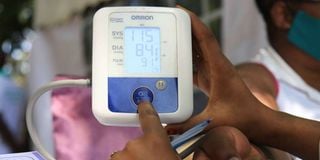Kenya tops Africa in cost of treating cancer in children

A health worker conducts a free wellness checkup during the launch of the national cervical cancer awareness week in Nanyuki town on January 19, 2021.
Kenya is losing her children to cancer due to the high cost of medicines, poor infrastructure, shortage of skilled personnel, lack of proper community awareness and late diagnosis.
According to a recent presentation on the status of childhood cancers in Kenya by Prof Jessie Githanga, a consulting oncologist at the Kenyatta National Hospital (KNH), the cost of medicines alone is irrationally high, at almost 40 per cent of treatment. As a result, the country is losing eight in every 10 children who are under cancer treatment.
Most affected families, she says, do not seek care, and for those who do, many do not complete the treatment. Prof Githanga led the research by an international team of medical experts to estimate the cost of treating childhood cancers in Africa.
In a study published in October in the journal, Cancer, the cost of childhood cancer treatment was found to be highest in Kenya compared to Tanzania, Nigeria, or Zimbabwe. Four leading childhood cancer treatment centres were assessed, each from the four countries, with Kenyatta National Hospital sampled for Kenya.
“The most expensive cost input was found to be associated with medication in Kenya, and medical personnel in the other three centres,” concluded the study.
Medications, the study says, accounted for nearly 40 per cent of the costs in Kenya, which is a substantially higher percentage than that of any of the other centres. The cost per new diagnosis ranged from Sh264,360 ($2,400) in Zimbabwe to 10 times higher in Kenya, at about Sh3.4 million ($31,000).
“The cost of cancer treatment in Kenya is up because patients, after being treated, choose to stay in hospitals,” said Prof Githanga.
That increases the cost, because, not only are they accumulating bills but also because their caregivers, parents or relatives add to the financial burden.
397,000 children
“The Sh3.4 million per cycle of treatment means that the whole costing is very high compared to some of our neighbouring countries,” she noted in an interview with the Nation.
About 397,000 children, ranging from newborn babies to 14-year-olds, are diagnosed with cancer annually, of whom more than 90 per cent live in low- and middle-income countries. Although cure rates for children with cancer residing in high income countries is estimated to exceed 80 percent, they are substantially lower in low- and middle-income settings, ranging from 55 to 60 percent.
In addition to the high cost of medicines, the study shows survival rates in Kenya at only 19 percent compared to 43 percent in Tanzania.
In another consequence of the high cost of medicines in Kenya, the report shows, more than half of the patients are likely to abandon treatment.
“Abandonment of treatment represents a major cause of treatment failure in low and middle-income countries, with rates of between 5 percent and 80 percent reported, the study noted.
The high rate of abandonment of treatment in Kenya, Prof Githanga says, is partly because many patients have no insurance cover.
Clinic capacity
At KNH, families are kept in the hospital throughout the treatment course because of inadequate outpatient clinic capacity and outpatient accommodations, as well as hospital billing policies.
As a result, hotelling costs at KNH were found to be far higher than those at the other three centres.
The Ethics and Anti-Corruption Commission (EACC) had reported Kenyans paying as much as 5,000 percent more for medicines and treatment in public hospitals.
For example, the commission said, a bladder operation would cost Sh7,500 for cash-paying patients, but Sh90,000 for those using insurance cards.
Even with a National Health Insurance Fund (NHIF) cover, Prof Githanga said, “ordinary Kenyans find tests too expensive to pay out-of-pocket and NHIF takes a lot of time to mature, therefore doesn’t take care of diagnostic tests right from the beginning”.
To reduce the cost, Prof Githanga said that one of the solutions is to cut off the middleman. Hospitals in seven countries, including KNH, are currently undertaking a study to investigate modalities of reducing the cost of cancer drugs.
“Some of our study partners have been going directly to manufacturers and so if we link up together and have one way of sourcing the drugs, it would be much better,” Prof Githanga said.
KNH and the Moi Teaching and Referral Hospital (MTRH) in Eldoret are the only public hospitals in Kenya offering comprehensive child cancer treatment. However, MTRH still refers cases to KNH for radiotherapy or those who can’t attend a private clinic in Eldoret.
KNH, with only 28 child cancer dedicated beds, admits about 100 children annually, with the majority accommodated in the general wards, denying them the required specialised care.
At the MTRH, cases of childhood cancer have been on the rise from about 70 in 2010 to 250 last year. Despite this, oncologists say they are only scratching the surface, with an estimated 3,500 children developing cancers annually in Kenya, but only about 1,000 diagnosed and getting any type of treatment.
“It means we are only diagnosing 25-30 percent of children with cancer and, unless we can substantially improve our reach, we cannot talk about improving survival rates,” said the head of child cancer unit at the MTRH, Dr Festus Njuguna, in a webinar organised by the Faraja Cancer Foundation.






